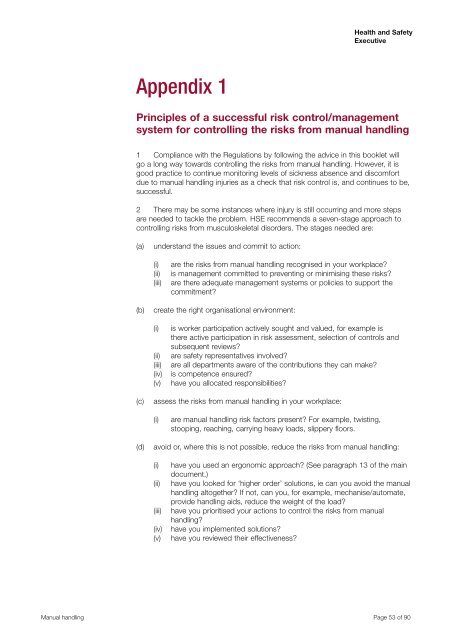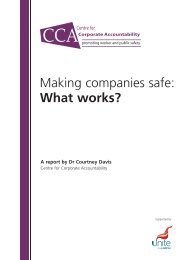Manual Handling Manual Handling Operations Regulations 1992 ...
Manual Handling Manual Handling Operations Regulations 1992 ...
Manual Handling Manual Handling Operations Regulations 1992 ...
Create successful ePaper yourself
Turn your PDF publications into a flip-book with our unique Google optimized e-Paper software.
Health and Safety<br />
Executive<br />
Appendix 1<br />
Principles of a successful risk control/management<br />
system for controlling the risks from manual handling<br />
1 Compliance with the <strong>Regulations</strong> by following the advice in this booklet will<br />
go a long way towards controlling the risks from manual handling. However, it is<br />
good practice to continue monitoring levels of sickness absence and discomfort<br />
due to manual handling injuries as a check that risk control is, and continues to be,<br />
successful.<br />
2 There may be some instances where injury is still occurring and more steps<br />
are needed to tackle the problem. HSE recommends a seven-stage approach to<br />
controlling risks from musculoskeletal disorders. The stages needed are:<br />
(a)<br />
understand the issues and commit to action:<br />
(i)<br />
(ii)<br />
(iii)<br />
are the risks from manual handling recognised in your workplace?<br />
is management committed to preventing or minimising these risks?<br />
are there adequate management systems or policies to support the<br />
commitment?<br />
(b)<br />
create the right organisational environment:<br />
(i)<br />
(ii)<br />
(iii)<br />
(iv)<br />
(v)<br />
is worker participation actively sought and valued, for example is<br />
there active participation in risk assessment, selection of controls and<br />
subsequent reviews?<br />
are safety representatives involved?<br />
are all departments aware of the contributions they can make?<br />
is competence ensured?<br />
have you allocated responsibilities?<br />
(c)<br />
assess the risks from manual handling in your workplace:<br />
(i)<br />
are manual handling risk factors present? For example, twisting,<br />
stooping, reaching, carrying heavy loads, slippery floors.<br />
(d)<br />
avoid or, where this is not possible, reduce the risks from manual handling:<br />
(i)<br />
(ii)<br />
(iii)<br />
(iv)<br />
(v)<br />
have you used an ergonomic approach? (See paragraph 13 of the main<br />
document.)<br />
have you looked for ‘higher order’ solutions, ie can you avoid the manual<br />
handling altogether? If not, can you, for example, mechanise/automate,<br />
provide handling aids, reduce the weight of the load?<br />
have you prioritised your actions to control the risks from manual<br />
handling?<br />
have you implemented solutions?<br />
have you reviewed their effectiveness?<br />
<strong>Manual</strong> handling Page 53 of 90
















